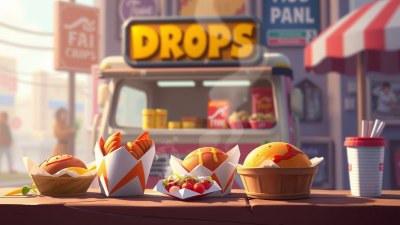Loot Drops in the Form of Street Food
Discover the exciting world of street food-inspired loot drops in gaming culture.

Image created with Flux Schnell
In the ever-evolving landscape of gaming, loot drops have become a thrilling feature that entices players with the promise of rewards. Traditionally associated with rare items, weapons, or currency, the concept of loot drops has recently undergone a creative transformation. Enter street food – the vibrant, eclectic, and delicious dishes that reflect the heart of different cultures worldwide. This article explores how the incorporation of street food as loot drops can enrich gaming experiences, enhance player engagement, and create unique narratives within virtual worlds.
The Intersection of Gaming and Culinary Culture
As gaming continues to grow as a dominant form of entertainment, reflecting real-world elements within virtual environments has become increasingly popular. The straightforward idea of integrating street food into loot drops serves not only to enhance the aesthetic of the game world but also appeals to the growing number of players who appreciate culinary experiences. Imagine exploring a bustling city in a role-playing game only to find a hidden food truck that offers players rewards in the form of unique street food.
The Appeal of Street Food
Street food is representative of cultural diversity, making it a relatable and enticing option for loot drops across numerous genres. Players can connect with their own favorite dishes, be it tacos from Mexico, samosas from India, or dim sum from China. Integrating these culinary delights into gameplay encourages players to explore, engage, and reminisce about their real-world dining experiences. Each dish can come with a set of attributes, enhancing the player's character, boosting abilities, or even providing temporary boosts during gameplay.
Types of Loot Drops Inspired by Street Food
When it comes to incorporating street food into loot drops, developers have endless possibilities. Here are a few examples of exciting street food loot drop concepts that can enhance gaming:
1. Unique Buffs and Boosts
Each loot drop representing a specific street food item can offer unique benefits. For instance, a 'Spicy Taco' loot drop might provide a temporary increase in speed for a racing game. On the other hand, 'Steamed Buns' could regenerate health faster when consumed. These buffs and boosts encourage players to seek out different dishes, adding an element of strategy to their gameplay.
2. Collectible Recipes
Street food loot drops could also come in the form of collectible recipes. Upon discovering a rare dish, players can unlock cooking challenges where they must gather ingredients within the game world. Completing a recipe could yield food items that not only enhance their character's abilities but also have a visual effect that showcases the dish in the game environment.
3. Aesthetic Enhancements
Players may also receive aesthetic loot drops that allow them to customize their character or avatar with clothing or accessories based on iconic street food. For example, a 'Ramen Headband' or 'Hot Dog Costume' could be fun additions, contributing to the player’s individuality while boosting morale in the game.
4. Cultural Celebrations as Events
Developers can host in-game events that center around street food culture, introducing limited-time loot drops that coincide with real-world food festivals or holidays. This can encourage players to participate, explore new virtual areas, and possibly meet new friends who share a love for both gaming and food.
Examples of Successful Integrations
Several games have successfully integrated food into loot drops, paving the way for street food-themed rewards. Each case highlights how food items have encouraged players to explore and engage with the game:
1. Monster Hunter World
Capcom’s 'Monster Hunter World' features a unique culinary aspect with the 'Canteen,' where players can prepare meals with ingredients gathered throughout their hunts. These meals can provide buffs that enhance health and stamina, showcasing how food can be both functional and flavorful.
2. Stardew Valley
In 'Stardew Valley,' players can collect recipes and ingredients to create popular dishes. With a focus on farming and gathering, players must explore their environment to discover hidden culinary secrets, mirroring the scavenger hunt aspect of loot drops.
3. Fall Guys
In a more whimsical take, 'Fall Guys' features food-inspired costumes and themes throughout its phases. Collecting these pieces adds an element of fun and encourages players to participate in themed events, forming a delightful intersection between gaming and culinary enjoyment.
The Future of Food in Gaming
As gaming continues to develop, the future of integrating street food into loot drops holds exciting potential. With advancements in technology, developers can create increasingly immersive experiences that combine cooking, hunting, and exploration. Interactive narratives where players must track down ingredients, cook meals, and compete in challenges can redefine how players interact with their virtual environments.
Moreover, as gaming has proven to be a uniting force, the universal love for food can draw together diverse gaming communities. Future expansions might include not just loot drops, but entire culinary quests where cooperation is needed among players to create dishes that could unlock epic loot rewards or defeat in-game challenges.
Challenges and Considerations
While the integration of street food into gaming opens a world of possibilities, developers must remain aware of the challenges involved. Cultural sensitivity is paramount when designing food-related content. Careful consideration should be given to ensure that food items pay homage to the cultures they represent without falling into stereotypes. It's essential that developers engage with cultural experts and diverse teams to create authentic and respectful representations.
Loot drops in the form of street food are a creative frontier in the gaming industry, blending culinary culture with game mechanics to enhance player experiences. By offering unique buffs, aesthetic enhancements, and a chance to engage with local traditions, game developers can create richer, more immersive worlds. This approach not only entertains but also educates players about diverse cultures and culinary practices, fostering a vibrant community that shares a love for gaming and food.











